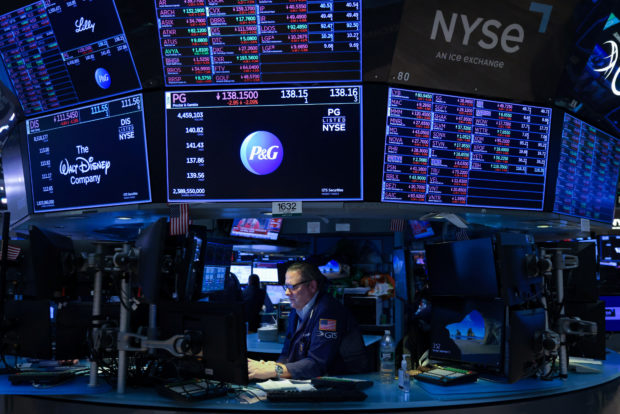
A trader works on the trading floor at the New York Stock Exchange (NYSE) in Manhattan, New York City, U.S. REUTERS/Andrew Kelly/File photo
NEW YORK – Wall Street ended sharply lower on Thursday, extending its losses in late afternoon trading as a raft of economic data failed to alter the expected course of aggressive tightening by the Federal Reserve amid growing warnings of global recession.
The sell-off gathered momentum toward the end of the session, with market leaders including Microsoft Corp, Apple Inc and Amazon.com Inc hitting the tech-laden Nasdaq hardest.
After the bell, FedEx Corp tumbled 14.5 percent after the package delivery company said its fiscal first-quarter results were hit by global volume softness and it withdrew its financial forecast, saying it expected further deterioration of business conditions.
FedEx’s warning sent shares of rival United Parcel Service down 5.7 percent in extended trade.
Earlier, in Thursday’s trading session, the benchmark S&P 500 closed a hair above 3,900, seen by many analysts as a key technical support level that has been tested several times over the past two weeks.
Interest rate-sensitive banks helped soften the blue-chip Dow’s decline.
“It’s been a difficult year and investors are wary,” said Matthew Keator, managing partner in the Keator Group, a wealth management firm in Lenox, Massachusetts. “Until something changes the tie’s going to go the runner and that’s been the bear.”
That scale tipped further to the bear side after the World Bank and the International Monetary Fund (IMF) warned of an impending global economic slowdown.
A mixed bag of economic data, led by better-than-expected retail sales, cemented the likelihood of another 75 basis-point interest rate hike from the Fed at the conclusion of next week’s monetary policy meeting, as uncertainties simmered over where the central bank will go from there.
“The question is what’s going to happen in November?” said Robert Pavlik, senior portfolio manager at Dakota Wealth in Fairfield, Connecticut. “If the Fed really wants to handle it properly, it will be 50 basis-point drop in November, a 25 basis-point cut in December, and then they’ll reassess.”
While the retail print surprised to the upside, declining jobless claims reaffirmed the labor market’s strength, and a drop in import prices supported the past-peak inflation narrative.
But a surprise drop in industrial production and a contraction of Atlantic region manufacturing provided fodder for economic pessimists.
None of the data appeared to change the calculus regarding Fed expectations. Financial markets have now fully priced in an interest rate increase of at least 75 basis points next Wednesday, with a one-in-five chance of a super-sized, 100-basis-point hike, according to CME’s FedWatch tool.
U.S. railroads remained open after the Biden administration helped broker a tentative deal with unions to avert a strike, thereby avoiding a rail shutdown which would add to supply-chain pressures at the core of hot inflation.
Shares of railroad operators Union Pacific and Norfolk Southern outperformed the broader market.
Adobe Inc tumbled after the company said it would buy Figma in a deal valued at about $20 billion.
The Dow Jones Industrial Average fell 173.27 points, or 0.56 percent, to 30,961.82, the S&P 500 lost 44.66 points, or 1.13 percent, to 3,901.35 and the Nasdaq Composite dropped 167.32 points, or 1.43 percent, to 11,552.36.
Nine the 11 major sectors of the S&P 500 ended the session in negative territory. Energy shares showed the largest percentage drop as the tentative rail agreement and demand concerns sent crude prices tumbling.
Healthcare posted the biggest advance with an assist from health insurer Humana Inc, whose 8.4% surge following its strong earnings forecast made it the top gainer in the S&P 500.
Adobe Inc was the S&P 500’s biggest percentage loser, tumbling 16.8 percent after the company said it would buy Figma in a cash-and-stock deal that valued the online design startup at about $20 billion.
Declining issues outnumbered advancing ones on the NYSE by a 2.79-to-1 ratio; on Nasdaq, a 1.35-to-1 ratio favored decliners.
The S&P 500 posted no new 52-week highs and 21 new lows; the Nasdaq Composite recorded 16 new highs and 206 new lows.
Volume on U.S. exchanges was 11.11 billion shares, compared with the 10.35 billion average over the last 20 trading days.

